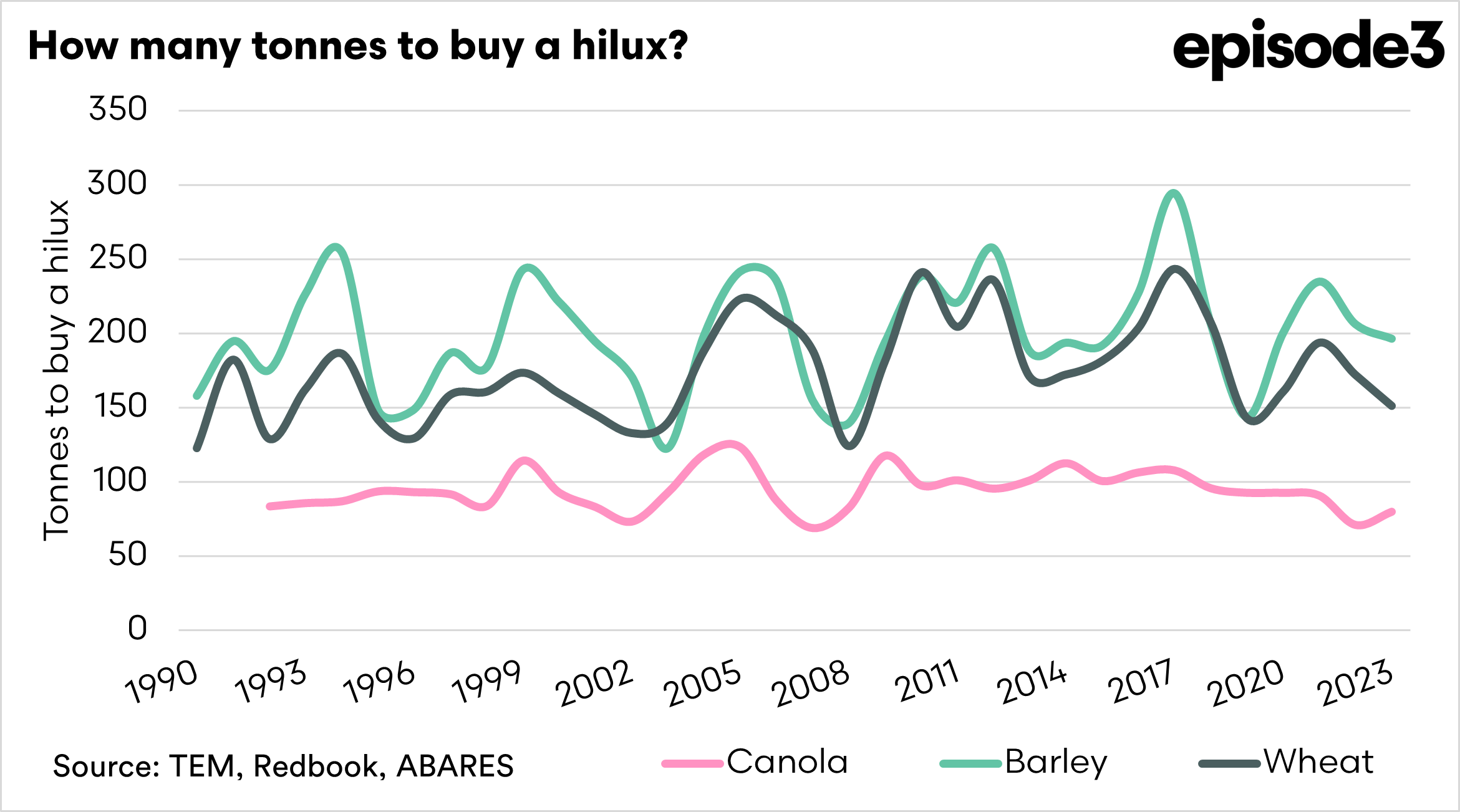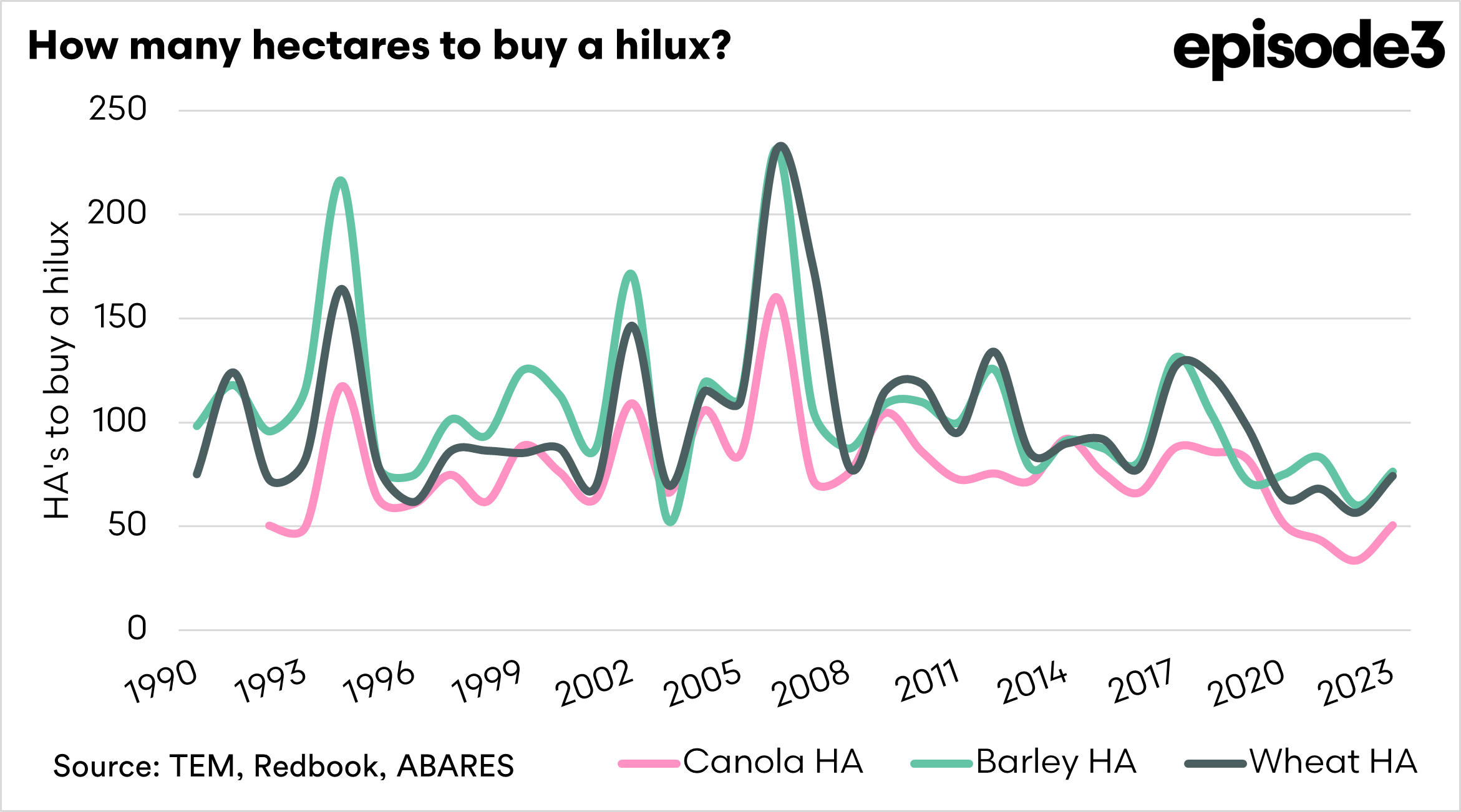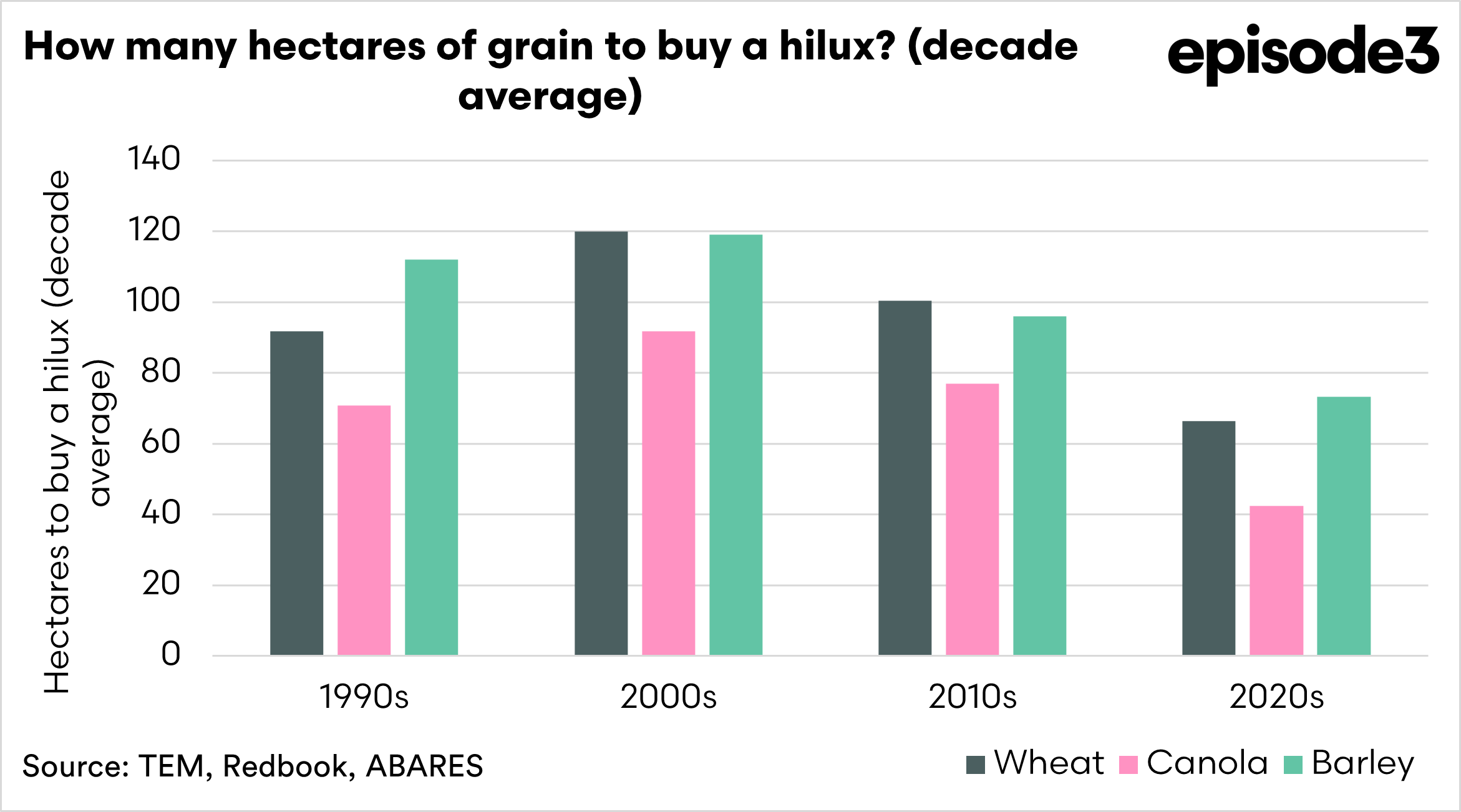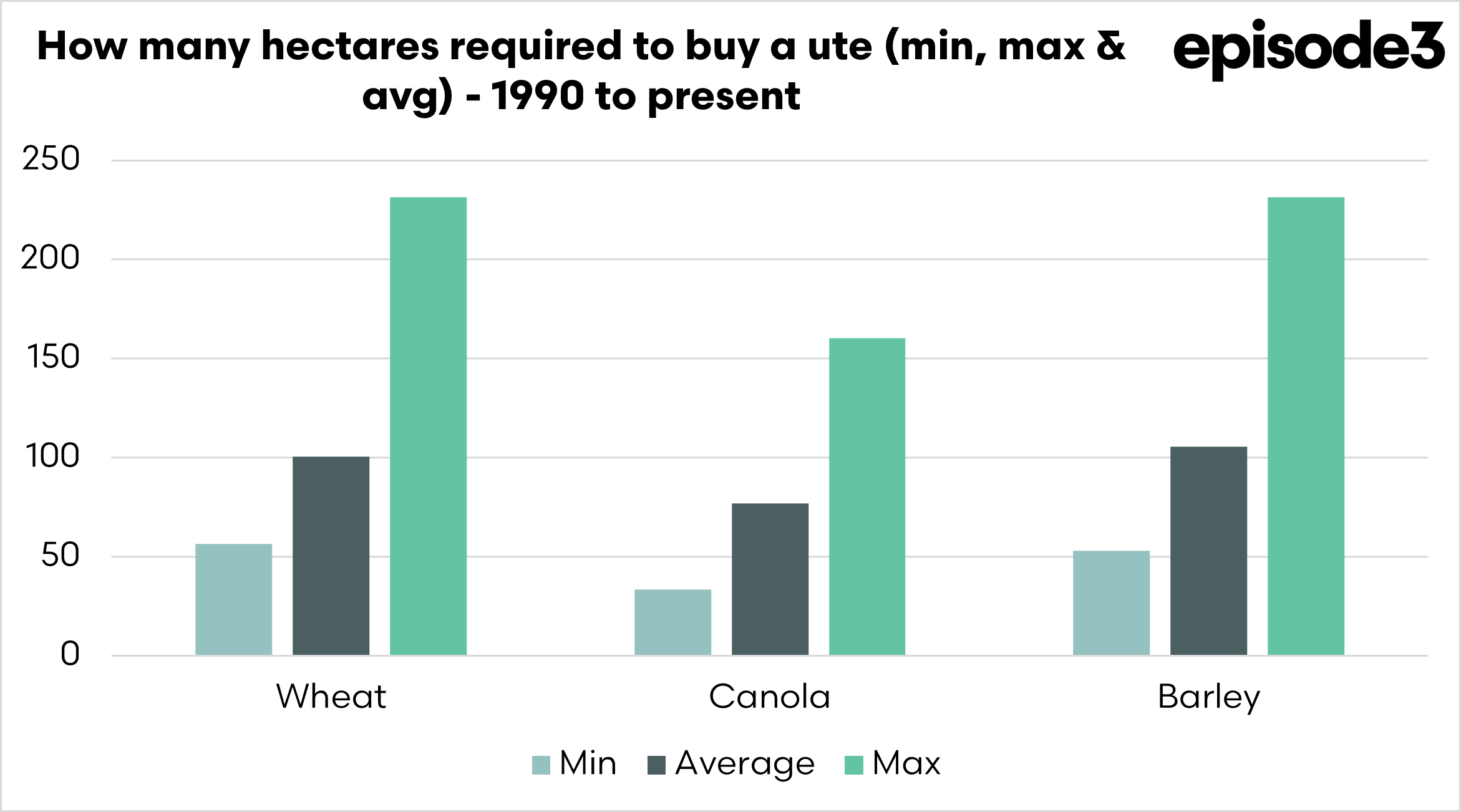Utes – a cost for croppers to bear?
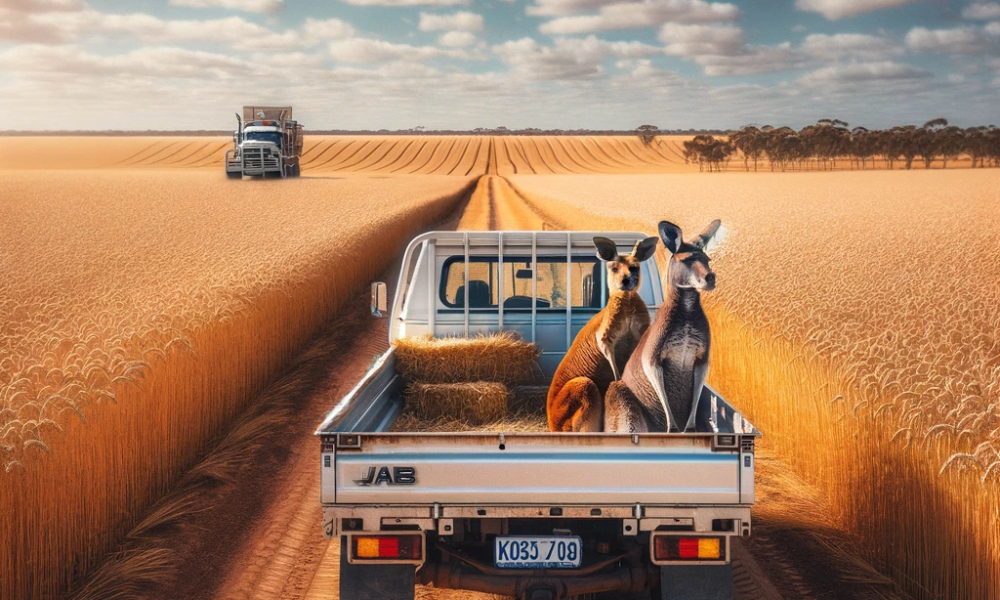
The Snapshot
- The analysis uses average yields and prices to show trends in ute affordability based on grain production needed to buy a Hilux.
- Recent years have been favorable for farmers buying utes, requiring less land per purchase due to high prices and yields.
- 2022 was the best year since 1990 to buy a ute as a grain farmer.
- 2006 was the worst year since 1990 to buy a ute as a grain farmer.
- The New Vehicle Efficiency Standard aka ‘ute tax’ may increase costs, affecting new and second-hand ute affordability.
- The ‘ute tax’ based on media-quoted figures would have meant that 18ha of wheat, 12ha of canola or 19ha of barley would be required to cover the costs of a new hilux in 2023.
The Detail
At episode 3, we collect a lot of data on a lot of different areas. We don’t even use some datasets that often, but we collect them just in case they become useful.
One of the datasets that we decided to track was the new cost of a ute in Australia (excluding government costs) from the early 80s to the present.
Why do we keep this data because the ute is the workhorse of Australian farms, and its cost is a good indicator to keep track of to determine the relative value to the cost of our outputs (meat, wool and grain).
In this article, I will take a look at how much you have to produce to purchase ute, and the impact of the coming ‘ute tax’. The ute we use in our analysis is the hilux, as it has the longer production run of the popular utes.
To conduct this analysis, we have used averages; it will be different depending upon the price you receive and the yield you get for your grain. We used the average Australian yield, as per ABARES, and an average Australian price.
It isn’t intended to accurately represent an individual’s farm but an overall trend.
The first chart above shows how many tonnes it would take to buy a ute. So let’s see what it was like last year compared to the average since 1990:
- Wheat: 151mmt versus 174mt average
- Canola: 79mt versus 94mt average
- Barley: 196mt versus 199mt average
Last year, a below-average volume of grain was required to buy a ute, but we need to look closer and examine the amount of area required.
Cropping has advanced, and Australian farmers are producing much more per hectare than ever. To get the true cost of the ute, you need to see how many hectares are required to be farmed to buy one.
So we handily provide that information with the above chart. If we look at the data from that chart, we can see that 2022 was ranked 1st best year for buying a Hilux as a canola/wheat farmer and the 2nd best for barley.
This was a combination of great prices and huge yields.
If we look at the period from the 1990s to the present, this current decade has actually been the best for farmers to invest in a ute. On average, you’d use fewer hectares to purchase the same ute specification.
So, this may be one of the reasons why ute sales have been so strong, and it may be an excuse to opt for one of the higher-spec models.
The chart above shows the lowest, average and highest area required to purchase a Hilux. It is quite a wide range. The most expensive, relative to production, to buy a ute was in 2006. A year when prices weren’t that high, and production was also poor
We can’t talk about utes without talking about the ‘ute tax’.
New Vehicle Efficiency Standard
The Australian government is introducing the New Vehicle Efficiency Standard (NVES), commonly referred to as the ‘ute tax’.
The NVES aims to incentivise car manufacturers to produce, or in reality import, more ‘cleaner’ vehicles into Australia than they currently do.
According to the government, new passenger cars in Australia use 20% more fuel than in the US/Europe markets, although this could be due to the higher number of 4x4s than in these nations.
The proposal will see manufacturers given an average CO2 target, which they must meet. If they sell a lot of utes, then they will have to sell a lot more low-emissions vehicles in order not to get fined, or they will have to pay the fine and pass this on to the buyers of the vehicles.
It is important to note that this NVES will apply to new cars, but in reality, it will increase the cost of 2nd hand cars, especially utes or large SUVs.
The chart above shows the area that you need to crop in 2023 to purchase a Hilux, but I have also added a second bar, which takes into account the addition of a new NVES cost that many newspapers are quoting (approx A$15k). This
This requires a significant additional area to be grown to cover the costs of a Hilux. 2023 was also a decent year for buying a Hilux (5-8th best in 32 years); not all years will have the same price/yields.
I advocate for better fuel efficiency in vehicles for environmental and cost reasons. Manufacturers should be moving to more efficient vehicles. They do, however, have to be vehicles that are fit for the purposes required of the user; this is especially the case in regional areas where safety is an important consideration to take into account.
It will be interesting to see how manufacturers react to this change, as Australia is a small market and one of a few countries that use right-hand drive vehicles.


